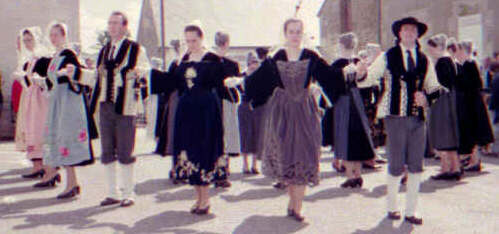
spirituality

genetics
The Cure: continued /5
It was midnight before Père Benoît finished the work that had to be done, and early next morning he was awoken by a banging at the door. Answering the knock in his nightclothes and the blue striped towelling dressing gown his niece had bought him last year, he found three workmen waiting. They drank café au lait while he hurriedly dressed, and then he was able to show them what he wanted them to do.
— No problem, Père! said the oldest of the workmen, and they started at once.
After Mass, le Père was approached by a tall gentleman with a moustache and a notebook, who introduced himself as a reporter from the local newspaper. He had heard about the Pardon and would le Père mind giving an interview?
The old priest went back to his house feeling that his bubble of delight had returned a hundredfold bigger. He took a trip to the garden centre on the Baud road and was delighted to find that they had exactly what he wanted.
Above the Place de l'Eglise on Sunday, white clouds obscured the sky, and there was no sun to bake the tarmac on which was parked not a single car. However, the weather forecast was good for the rest of the day, and the only reason there were no cars parked was that the Place was roped off to make space for the Breton dancing. Madame Ségale was doing brisk business at the Boulangerie, but this time the church, too, was busy. This week he had four altar servers. Not only had Yves come back, but he had acquired two new young recruits during the week, Chantal and Marie-Thérèse.
Père Benoît had prepared his Mass carefully and, as the metallic recording of the bells rang out over the village, he took a deep breath and paused to glance up at the crucifix. Le Sauveur's expression was gently long-suffering, as ever. Le Père said a short prayer of thanksgiving and a hope for the success of the supreme efforts he had put in this week past.
That moment was the last quiet and peaceful time in the whole day. Père Benoît was whirled from one moment to the next, as the day's schedule took on a life of its own and planned events came to life. The spectacle he had seen only in his head — in his dreams — unfolded before him in substance and colour he could never fully have imagined. True, the times at which things happened bore little resemblance to those advertised in the photocopied leaflet entitled "Schedule", but July days are long, and no-one seemed to mind.
When the priest saw all the schoolchildren in their traditional outfits, he was
overcome. Several of the boys wore felt jackets with silver buttons down the front and
wide black hats, others wore multicoloured waistcoats. The preponderance of trainers and
track suit trousers did not detract from the rustic effect. Over black T-shirts and black
skirts in every shape and size, the little girls wore aprons each in a single colour, some
edged with braid, some patterned with applique, many simply plain. Some of their coiffes
were not entirely straight on modern haircuts, and, as well as the traditional Baud style
of a close fitting round lace hat with lace wings curling outward from the sides there
were lace caps with long lace ribbons down the back. 
The mixture of styles was reflected in the adults, whose black dresses were partnered with
aprons in every colour and material, some obviously handed down in a family for several
generations, magnificently embroidered, and others new, in a cutwork style.
The procession was long and decorous, with locals, visitors and tourists joining in behind. It was led by the band playing jolly martial tunes and even, in deference to le Père, the occasional hymn. In pride of place in the procession was the statue of Sainte Anne from the church, supported in a special cradle and borne on the shoulders of four generations of the Barnard family, including le Père's long-time friend François.
The Cure  this story continued
this story continued
Part of this work was submitted as the Dissertation for the MA in Writing
at
Nottingham Trent University